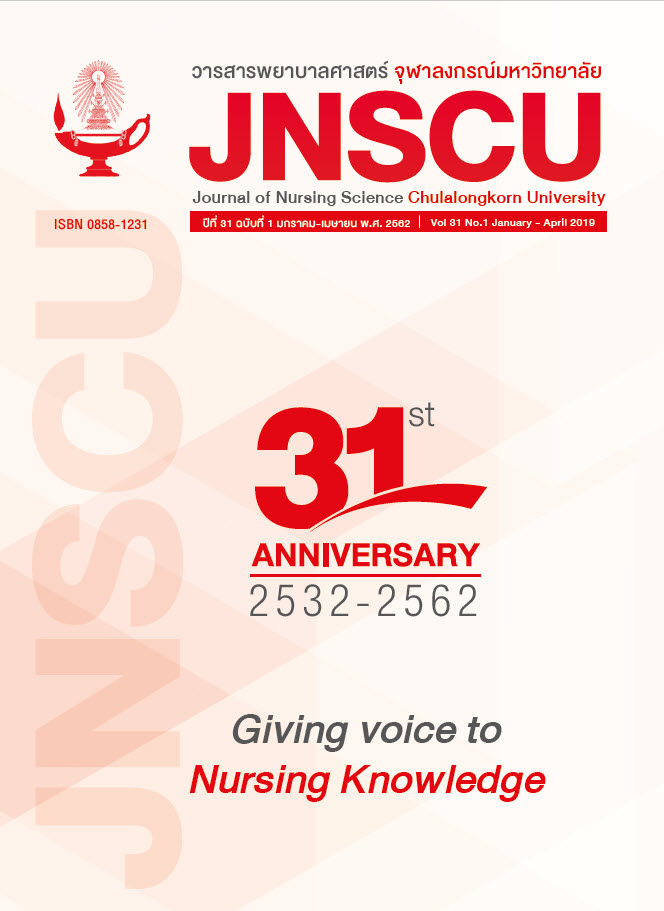Self-management Experiences of Asthma in School-age Children
Keywords:
Self-management, School-age children, AsthmaAbstract
Objective: To explore the experiences of self-management in school-age children with asthma.
Research design: Descriptive qualitative research.
Methods: The informants were 26 school-age children with asthma who came to the Asthma and Allergy Clinic in the Out-Patient Department at Thammasat University Hospital who were selected by purposive sampling. Data was collected by conducting in-depth interviews, transcribed verbatim and analyzed by content analysis.
Findings: The informants were composed of nineteen boys and seven girls with asthma with ages ranging from 9-12 years and an average age of 10.5 years, standard deviation was 1.1 years. According to the data analysis, the experiences of the school-age children with self-management of asthma were composed of the following four themes. First, the perception about asthma comprised two aspects, namely, unlike their friends, and unhealthy person. Second, impact of the disease included disturbances of daily life and academic performance. Third, children began to take responsibility for asthma management, including avoiding triggers, taking medications, and monitoring asthma symptoms. The fourth was that feelings about asthma self-management was composed of two perspectives; recognition of the importance in practice, and the difficulties to the implementation of asthma management.
Conclusion: The findings of this study provide understanding about experiences with self-care aimed at asthma management in school-age children and can be implemented as guidelines for the formation of programs for promoting self-management in school-age children with asthma.
References
Centers for Disease Control and Prevention[Internet]. Asthmafacts: CDC’snationalasthma control program grantees July2013. [cited 2017 Aug 22]. Available
from:https://www.cdc.gov/asthma/pdfs/asthma_facts_program_grantees.pdf
WinerRA, Xiaoting QIN, HarringtonT,MoormanJ, Zahran H. Asthma incidence amongchildren and adults: Findings from thebehavioral riskfactorsurveillancesystemasthmacall-backsurvey—United States,2006-2008. J Asthma 2012;49(1):16-22.
WanlapakornN,SritippayawanS,DeerojanawongJ.Prevalenceofasthma, levelofcontroland factors associated with asthmacontrol in Thai elementary schoolstudents inBangkok. AsianPacJ AllergyImmunol 2014;32(4):287-92.
The Global Asthma Network [Internet]. TheGlobal AsthmaReport2014. [cited 2017Aug 22]. Available from: http://www.globalasthmanetwork.org/publications/Global_Asthma_Report_2014.pdf
Akinbami OJ, Moorman JE, Liu X [Internet].Asthma prevalence, health care use,andmortality: United States,2005-2009.[cited 2017May1]. Availablefrom:
https://www.aap.org/en-us/Documents/medicalhome_resources_asthma_prevalence.pdf
Ahmad E, Grimes DE. The effects of selfmanagementeducationfor school-agechildrenonasthmamorbidityasystematicreview. J Sch Nurs 2011;27(4):282-92.
Ryan P, Sawin KJ. The Individual and familyself-management theory: Backgroundand perspectives on context, process,and outcomes. Nurs Outlook2009;57(4):217-25.
FriendM,Morrison A. Interventionstoimproveasthmamanagementof theschool-agechild. Clin Pediatr 2015;54(6):534-42.
Harris KM, Kneale D, Lasserson TJ, McDonaldVM, Grigg J, Thomas J. School-basedself-management interventions forasthma in children and adolescents: Amixed methods systematic review.
Cochrane Libr 2015; 4:1-20.
TooleKP.Helpingchildrengainasthmacontrol:Bundled school-based interventions.Pediatr Nurs 2013;39(3):115-24 .
Trent CA, Zimbro KS, Rutledge CM. Barriersin asthma care for pediatric patients inprimarycare. JPediatr Health Care2015;29(1):70-9.
Lincoln YS, Guba EG. Naturalistic inquiry.Newbury Park, CA: Sage Publications;1985.
Brown N, Gallagher R, Fowler C, Wales S.Theroleof parents inmanagingasthmain middle childhood: An importantconsiderationinchroniccare. Collegian2010;17(2):71-6.
Hockenberry MJ, Wilson D, Rodgers CC.Wong’s essentials of pediatric nursing.10th ed. Missouri: Elsevier; 2017.
Saraban, L., Thoranasonton, S., Chu-ngan,T., &Wongwirud,S., Dyspneaexperience,symptom management and outcomesamongcaregiversofschool-ageasthmaticchildren. Songklanagarind Journal of
Nursing (2012), 32(2), 23-26. (in Thai]
Haughney J, Price D, Kaplan A, Chrystyn H,HorneR, May N,etal. Achievingasthmacontrol in practice: Understanding thereasons for poor control. Respir Med2008;102(12):1681-93.
EkimA, Ocakci AF.Perceptionsof parentsandchildrenregardingasthmamanagementresponsibilities. J Spec Pediatr Nurs2013;18(4):289-96.
GandhiPK,KenzikKM,ThompsonLA, DeWaltDA, Revicki DA, Shenkman EA, et al.Exploring factors influencing asthmacontrol and asthma-specific healthrelated quality of life among children.Respir Res 2013;14:1-10.
Yeh H-Y, Ma W-F, Huang J-L, Hsueh K-C,ChiangL-C.Evaluatingtheeffectivenessof a family empowerment program onfamilyfunctionand pulmonaryfunctionof children withasthma: A randomized
control trial. Int J Nurs Stud 2016;60:
-44.
Downloads
Published
Issue
Section
License
ลิขสิทธิ์ของบทความที่ตีพิมพ์เป็นของวารสารพยาบาลศาสตร์ จุฬาลงกรณ์มหาวิทยาลัย ทั้งฉบับตีพิมพ์เป็นรูปเล่มและเอกสารออนไลน์



